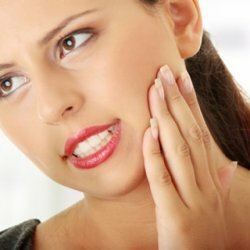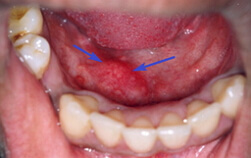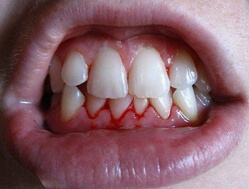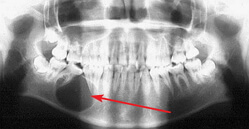Pericoronaritis. Causes, symptoms, treatment, prevention
 Pericoronaritis is an inflammatory disease. Inflammation occurs in the tissues of the gums, around the erupting teeth of "wisdom."Accompanying inflammation with suppuration, sharp pain, soreness when swallowing and even when opening the mouth. Inflammation provokes plaque, formed in the gum apertures when the teeth come out "wisdom."To cause inflammation, there may be a load on adjacent teeth when the tooth emerges "wisdom", which leads to damage to bone tissue, but suffers and the gum.
Pericoronaritis is an inflammatory disease. Inflammation occurs in the tissues of the gums, around the erupting teeth of "wisdom."Accompanying inflammation with suppuration, sharp pain, soreness when swallowing and even when opening the mouth. Inflammation provokes plaque, formed in the gum apertures when the teeth come out "wisdom."To cause inflammation, there may be a load on adjacent teeth when the tooth emerges "wisdom", which leads to damage to bone tissue, but suffers and the gum. Causes of inflammation:
- Mechanical gum injuries;
- Embryological conditions;
- State of the microflora of the oral cavity;
- Difficult wisdom tooth exit.
- Increased tissue density of the alveolar process;
- Reducing the distance for the exit of the tooth "wisdom";
- Thickening of the mucosa.
- Severe pain in the gum area;
- Increase in the size of lymph nodes;
- Purulent discharge from the gum with pressure;
- Swelling of the gums;
- Increased body temperature and bad breath.
In the acute stage, pericoronaritis extends to the masticatory muscles, it is problematic to open the mouth. The pain flows into the ear and the temple, intensifying when swallowing and chewing. The acute phase can be complicated by the following diseases:
- Osteomyelitis;
- Abscess;
- Soft tissue phlegmon;
- Postamolar periostitis.
Treatment of periconitis
At the initial stage, treatment can be performed at home. Inflammatory process removes the solution of potassium permanganate. It removes the inflammation of furatsilin well. Rinse the mouth with saline. Salt is desirable to take sea. A good result is given by the soda solution. Antiseptic effect has broths of medicinal herbs: nettle, sage, chamomile and marigold. It would be good to take inside 10% solution of calcium chloride( 15 ml).Severe pain can be removed with any anesthetic.
But completely cure pericoronaritis is impossible. The method of treatment is surgical. The surgeon cuts the inflamed and festering "hood" over the tooth. Anesthesia is local. After the operation, the oral cavity is rinsed with antiseptics.
If the wisdom tooth does not cut correctly, then it is removed. This happens in case of tooth growth in the cheek area, lack of space in the jaw.
X-rays are used for the diagnosis. They treat the disease with the help of a laser. Infrared ray, passing through the skin, has an effect on the inflamed area. Increased blood flow to the inflamed place, stimulates metabolism, passes inflammation, and swelling subsides. The infrared ray also acts as an analgesic. It is enough 10 sessions. Contraindication can only be an oncological process in the oral cavity. The choice of method depends on the degree of inflammation.
If the inflammatory edema is significant or if the jaw is compressed, then trigeminosimpathic blockade is used. If there are no complications, then the doctor simply rinses the pocket formed under the hood, a weak solution of some antiseptic.
Prevention of pericoronaritis
It is possible to prevent the occurrence of periconaritis if you regularly go to the dentist for oral examinations. He at an early stage will identify the inflammatory process, and this will avoid complications. Preventive measures include the careful care of the oral cavity. But at the beginning of inflammation this procedure will not save.



